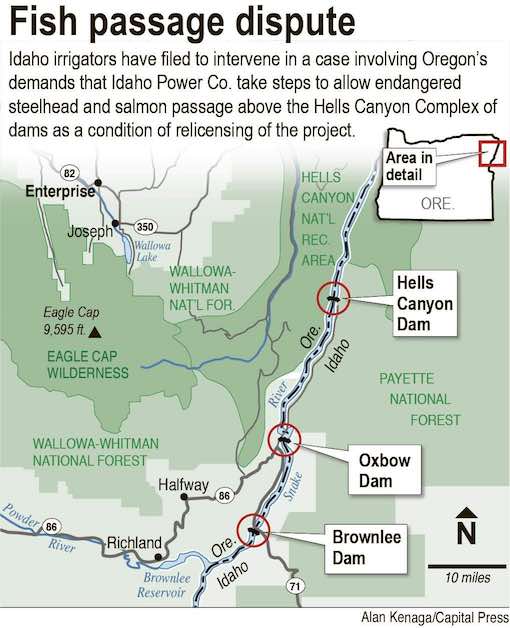forum
library
tutorial
contact

Idaho Irrigators Oppose Oregon
Endangered Fish Reintroduction Effort
by John O'Connell
Capital Press, January 6, 2017
|
the film forum library tutorial contact |

|
Idaho Irrigators Oppose Oregon
by John O'Connell
|
Irrigators in Idaho are fighting an effort by the State of Oregon to reintroduce endangered
steelhead trout and chinook salmon to the Snake River above Hells Canyon.
 BOISE -- Idaho irrigators fear they'll be hurt financially if the State of Oregon prevails in a legal battle to force the reintroduction of endangered fish to the Snake River upstream of the Hells Canyon Complex of dams.
BOISE -- Idaho irrigators fear they'll be hurt financially if the State of Oregon prevails in a legal battle to force the reintroduction of endangered fish to the Snake River upstream of the Hells Canyon Complex of dams.
"If you have a listed species above Hells Canyon in the Snake River and tributaries, you're going to have an alphabet soup of environmental laws imposed," said Norm Semanko, executive director with Idaho Water Users Association.
Construction of the Complex -- which is located at the Idaho and Oregon border and includes the Brownlee, Oxbow and Hells Canyon dams -- was started in the mid-1950s. The dams provide about 30 percent of Idaho Power Co.'s total energy, but they've blocked the migration of native chinook salmon and steelhead trout, which once used the upstream channel and tributaries for spawning.
The original federal license to operate the Complex expired in 2005, and the Federal Energy Regulatory Commission issued a final environmental impact statement for the relicensing in 2007. But the new license has been delayed as Idaho Power awaits Clean Water Act certifications from the states of Idaho and Oregon.
Both states have issued draft certifications, which are in the midst of public comment periods that end Feb. 13. Oregon's draft would require Idaho Power to implement technology to enable salmon and steelhead to pass above and below the complex.
Marilyn Fonseca, hydropower program coordinator with the Oregon Department of Environmental Quality, explained her state has proposed a phased-in reintroduction plan spanning about two decades. Initially fish would be introduced in Oregon's Snake River tributaries upstream of the complex, starting with Pine Creek. Ultimately, Idaho Power officials said the company would capture fish in special collection areas, trucking adult steelhead and salmon upstream of the complex and juvenile fish downstream.
Fonseca said Oregon has a state law mandating fish passage past any manmade water obstruction, but the state's legal argument hinges its own water quality standards, drafted in accordance with the federal Clean Water Act, requiring that Oregon waterways maintain robust fish populations.
In a letter to Oregon leaders, Idaho Gov. Butch Otter opposed reintroduction of endangered species in his state without the Legislature's consent, citing problems with federally reintroduced wolves.
"While I appreciate Oregon's willingness to limit these reintroductions to Oregon tributaries, the agreement would result in reintroduced fish entering Idaho waters," Otter wrote.
Idaho Power spokesman Brad Bowlin said the company has filed a petition asking FERC to step in and resolve the dispute between the states. Bowlin said the company believes the federal government has authority under the Federal Power Act and the Supremacy Clause of the U.S. Constitution.
"Idaho Power's position is not to support or oppose fish passage," Bowlin said. "Our position is that resolving this issue of passage is a federal question, especially given that we have two states whose positions are diametrically opposed."
Bowlin said Idaho Power owns and finances four hatcheries and releases millions of fish below the dams.
Both the IWUA and Idaho Irrigation Pumpers Association have filed to intervene in the case before FERC. Lynn Tominaga, executive director for the pumpers, said his members are primarily concerned about increased power rates to run their wells if Idaho Power has to bear such a large new expense. Semanko explained his members are concerned the agreement could create water shortages, as more water could be demanded downstream for salmon, and cost them hundreds of millions of dollars in new regulatory requirements.
FERC staff members have agreed reintroduction "could be warranted but is premature at this time." They note degradation due to agricultural and municipal uses have made water quality upstream of the complex inadequate for steelhead and salmon. FERC has also referenced the lack of a written plan to guide reintroduction and fears mortality during migration could outweigh the benefits.
Fonseca said her department and its Idaho counterpart are working with partners, including Idaho Power, to address water-quality concerns including dissolved oxygen levels, high water temperature and excessive phosphorus loads.
learn more on topics covered in the film
see the video
read the script
learn the songs
discussion forum
